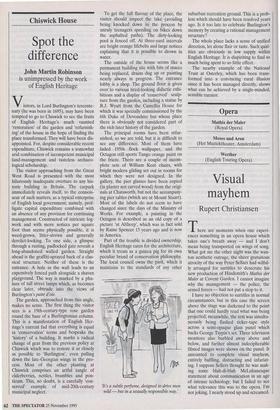Chiswick House
Spot the difference
John Martin Robinson is unimpressed by the work of English Heritage
Visitors, in Lord Burlington's tercente- nary (he was born in 1695), may have been tempted to go to Chiswick to see the fruits of English Heritage's much vaunted `restoration' of the garden and 'refurnish- ing' of the house in the hope of finding the place transformed. They will have been dis- appointed. For, despite considerable recent expenditure, Chiswick remains a somewhat arid combination of incompetent municipal land-management and tasteless archaeo- logical scholarship.
The visitor approaching from the Great West Road is presented with the most hilariously inadequate overture to any his- toric building in Britain. The carpark immediately reveals itself, to the connois- seur of such matters, as a typical enterprise of English local government; namely, prof- ligate capital expenditure combined with an absence of any provision for continuing management. Constructed of intricate log- work and with more notices per square foot than seems physically possible, it is weed-grown, litter-strewn and generally derelict-looking. To one side, a glimpse through a rusting, padlocked gate reveals a long-abandoned walled garden. Straight ahead is the graffiti-sprayed back of a clas- sical structure. Neither of these is the entrance. A hole in the wall leads to an expensively fenced path alongside a shaven playground. The way is marked by a pha- lanx of tall street lamps which, as becomes clear later, obtrude into the views of Burlington's patte d'oie.
The garden, approached from this angle, makes no sense. The first thing the visitor sees is a 19th-century-type rose garden round the base of a Burlingtonian column. This is a manifestation of English Her- itage's current fad that everything is equal in 'conservation' terms and bespeaks the `history' of a building. It marks a radical change of gear from the previous policy at Chiswick which was to restore it as closely as possible to 'Burlington', even pulling down the late-Georgian wings in the pro- cess. Most of the other planting at Chiswick comprises an artful tangle of elderberries, nettles, brambles and pon- ticum. This, no doubt, is a carefully 'con- served' example of mid-20th-century municipal neglect. To get the full flavour of the place, the visitor should inspect the lake (avoiding being knocked down in the process by unruly teenagers speeding on bikes down the asphalted paths). The dirty-looking pool is fenced off. At three-yard intervals are bright orange lifebelts and large notices explaining that it is possible to drown in water.
The outside of the house seems like a permanent building site with bits of stucco being replaced, drains dug up or painting nearly always in progress. The entrance lobby is a shop. The ground floor is given over to various tired-looking didactic exhi- bitions and a display of 'conserved' sculp- ture from the garden, including a statue by R.J. Wyatt from the Camellia House for which it was specially commissioned by the 6th Duke of Devonshire but whose place there is obviously not considered part of the rich later history of the garden.
The principal rooms have been refur- nished, so we are told, but it is difficult to see any difference. Most of them have faded 1950s flock wallpaper, and the Octagon still sports Tango orange paint on the frieze. There are a couple of incom- plete sets of William Kent chairs, with bright modern gilding set out in rooms for which they were not designed. In the gallery, the pier glasses have been copied (in plaster not carved wood) from the origi- nals at Chatsworth, but not the accompany- ing pier tables (which are at Mount Stuart). Most of the labels do not seem to have changed since the days of the Ministry of Works. For example, a painting in the Octagon is described as an old copy of a picture 'at Althorp', which was in fact sold by Raine Spencer 15 years ago and is now in America.
Part of the trouble is divided ownership. English Heritage cares for the architecture, which it treats as a guinea pig for its own peculiar brand of conservation philosophy. The local council owns the park, which it maintains to the standards of any other "it's a subtle perfume, designed to drive men wild — but in a sexually responsible way.' suburban recreation ground. This is a prob- lem which should have been resolved years ago. Is it too late to celebrate Burlington's memory by creating a rational management structure?
The whole place lacks a sense of unified direction, let alone flair or taste. Such qual- ities are obviously in low supply within English Heritage. It is dispiriting to find so much being spent to so little effect.
The nearby example of the National Trust at Osterley, which has been trans- formed into a convincing rural illusion since it has been managed directly, shows what can be achieved by a single-minded, sensible curator.


















































































 Previous page
Previous page